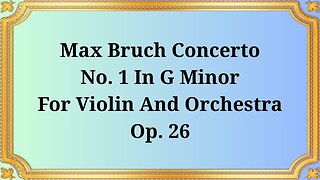Premium Only Content

Ludwig van Beethoven Concerto In D Major For Violin And Orchestra, Op 61
#BeethovenConcerto #classicalcomposers #violinconcerto #orchestralmusic #romanticera #musicalgenius #violinist #musicappreciation #musichistory #orchestration
Publication date 1951
ZINO FRANCESCATTI, Violin, with THE PHILADELPHIA ORCHESTRA, EUGENE ORMANDY, Conductor
Ludwig van Beethoven, one of the greatest composers in history, crafted a masterpiece that showcases his genius and innovation: the Concerto in D Major for Violin and Orchestra, Op. 61. In this essay, we will explore the historical context, musical elements, and enduring significance of Beethoven's majestic composition.
Composed between 1806 and 1807, Beethoven's Concerto in D Major reflects the transition from the Classical to the Romantic era of music. During this time, Beethoven was pushing the boundaries of traditional composition, infusing his works with emotional intensity and expanding the role of the soloist within the concerto format. This concerto stands as a milestone in Beethoven's career, showcasing his mastery of form and his drive for artistic innovation.
The Concerto in D Major is structured in three movements: the Allegro ma non troppo (fast but not too much), the Larghetto (slow and lyrical), and the Rondo: Allegro (fast and lively). Beethoven's composition showcases his ability to balance the virtuosity of the solo violin with the accompanying orchestra, creating a harmonious dialogue between the two. The concerto features captivating melodies, rich harmonies, and intricate passages that demand technical prowess from the soloist, while the orchestra provides a dynamic and expressive backdrop.
Beethoven's orchestration in the Concerto in D Major is notable for its innovative use of instruments and textures. He expanded the traditional orchestra, adding new instruments such as the piccolo, trombones, and contrabassoon. Beethoven's orchestral writing is rich and vibrant, with powerful brass fanfares, delicate woodwind solos, and lush string accompaniment. The interplay between the solo violin and the orchestra creates a compelling musical narrative, showcasing the soloist's virtuosity and the orchestra's ability to support and enhance the soloist's performance.
The Concerto in D Major has stood the test of time and remains one of Beethoven's most celebrated and frequently performed works. Its significance lies in its innovative approach to the concerto form, as Beethoven expanded the role of the soloist, giving the violin a more prominent and expressive voice. Additionally, the concerto's emotional depth, technical challenges, and memorable melodies have made it a favorite among violinists and audiences alike. Its enduring popularity is a testament to Beethoven's ability to create music that resonates with listeners across generations.
Ludwig van Beethoven's Concerto in D Major for Violin and Orchestra, Op. 61, stands as a testament to the composer's genius and his contribution to the evolution of classical music. The concerto's historical significance, innovative approach to form, and orchestral brilliance continue to captivate audiences, showcasing Beethoven's ability to push the boundaries of musical expression. As we listen to the majestic melodies and virtuosic performances of Beethoven's concerto, we are reminded of the profound impact of his artistic vision and his enduring legacy in the world of classical music.
You have the opportunity to support the channel https://destream.net/live/RadSiarAl/donate
-
 24:35
24:35
Classical music_Music Inspiration
19 days agoMax Bruch Violin Concerto No. 1 in G minor, Op. 26
851 -
 LIVE
LIVE
freecastle
2 hours agoTAKE UP YOUR CROSS- CREATED IN HIS IMAGE
109 watching -
 1:49:30
1:49:30
The Quartering
4 hours agoCount Dankula Live On Migrant Crisis In Europe, Whiteness & More
107K148 -
 3:46:59
3:46:59
Barry Cunningham
7 hours agoBREAKING NEWS: KAROLINE LEAVITT HOLDS WHITE HOUSE PRESS CONFERENCE (AND MORE NEWS)
61.9K46 -
 47:21
47:21
Stephen Gardner
21 hours ago🔥Elon Just Exposed the Most Corrupt Man on Earth - Trump Makes BOLD MOVE!
21K100 -
 56:48
56:48
The HotSeat
2 hours agoI'm NOT Sorry! Guns Aren’t the Problem—Godless Culture Is
5.19K7 -
![[Ep 737] Media & Left Attack Prayer and God | Media Loses Control of Narrative | CDL Fraud](https://1a-1791.com/video/fww1/ca/s8/1/m/N/f/d/mNfdz.0kob-small-Ep-736-Make-Gender-Dysphori.jpg) LIVE
LIVE
The Nunn Report - w/ Dan Nunn
2 hours ago[Ep 737] Media & Left Attack Prayer and God | Media Loses Control of Narrative | CDL Fraud
207 watching -
 2:53:12
2:53:12
Right Side Broadcasting Network
8 hours agoLIVE REPLAY: White House Press Secretary Karoline Leavitt Holds a Press Briefing - 8/28/25
111K44 -
 1:38:09
1:38:09
Simply Bitcoin
5 hours ago $2.48 earnedIs This Your LAST Chance to Buy Bitcoin Before the GENERATIONAL Bull Run Begins? | EP 1320
26.7K2 -
 LIVE
LIVE
StoneMountain64
3 hours ago#1 WARZONE TACTICIAN + New Battlefield Trailer
135 watching